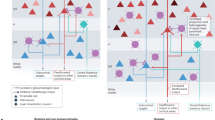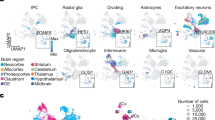Abstract
The developmental and evolutionary mechanisms behind the emergence of human-specific brain features remain largely unknown. However, the recent ability to compare our genome to that of our closest relative, the chimpanzee, provides new avenues to link genetic and phenotypic changes in the evolution of the human brain. We devised a ranking of regions in the human genome that show significant evolutionary acceleration. Here we report that the most dramatic of these ‘human accelerated regions’, HAR1, is part of a novel RNA gene (HAR1F) that is expressed specifically in Cajal–Retzius neurons in the developing human neocortex from 7 to 19 gestational weeks, a crucial period for cortical neuron specification and migration. HAR1F is co-expressed with reelin, a product of Cajal–Retzius neurons that is of fundamental importance in specifying the six-layer structure of the human cortex. HAR1 and the other human accelerated regions provide new candidates in the search for uniquely human biology.
This is a preview of subscription content, access via your institution
Access options
Subscribe to this journal
Receive 51 print issues and online access
$199.00 per year
only $3.90 per issue
Buy this article
- Purchase on Springer Link
- Instant access to full article PDF
Prices may be subject to local taxes which are calculated during checkout




Similar content being viewed by others
References
Enard, W. et al. Molecular evolution of FOXP2, a gene involved in speech and language. Nature 418, 869–872 (2002)
Evans, P. D. et al. Adaptive evolution of ASPM, a major determinant of cerebral cortical size in humans. Hum. Mol. Genet. 13, 489–494 (2004)
Hill, R. S. & Walsh, C. A. Molecular insights into human brain evolution. Nature 437, 64–67 (2005)
Kimura, M. The Neutral Theory of Molecular Evolution (Cambridge Univ. Press, Cambridge, 1983)
Chimpanzee Sequencing and Analysis Consortium. Initial sequence of the chimpanzee genome and comparison with the human genome. Nature 437, 69–87 (2005)
Clark, A. G. et al. Inferring nonneutral evolution from human–chimp–mouse orthologous gene trios. Science 302, 1960–1963 (2003)
Nielsen, R. et al. A scan for positively selected genes in the genomes of humans and chimpanzees. PLoS Biol. 3, e170 (2005)
Dorus, S. et al. Accelerated evolution of nervous system genes in the origin of Homo sapiens. Cell 119, 1027–1040 (2004)
Wang, X., Grus, W. E. & Zhang, J. Gene losses during human origins. PLoS Biol. 4, e52 (2006)
Waterston, R. H. et al. Initial sequencing and comparative analysis of the mouse genome. Nature 420, 520–562 (2002)
King, M. C. & Wilson, A. C. Evolution at two levels in humans and chimpanzees. Science 188, 107–116 (1975)
Pedersen, J. S. et al. Identification and classification of conserved RNA secondary structures in the human genome. PLOS Computat. Biol. 2, e33 (2006)
Hillier, L. W. et al. Sequence and comparative analysis of the chicken genome provide unique perspectives on vertebrate evolution. Nature 432, 695–716 (2004)
Lander, E. S. et al. Initial sequencing and analysis of the human genome. Nature 409, 860–921 (2001)
Nobrega, M. A., Ovcharenko, I., Afzal, V. & Rubin, E. M. Scanning human gene deserts for long-range enhancers. Science 302, 413 (2003)
Siepel, A. et al. Evolutionarily conserved elements in vertebrate, insect, worm, and yeast genomes. Genome Res. 15, 1034–1050 (2005)
Hedges, S. B. & Kumar, S. Genomics. Vertebrate genomes compared. Science 297, 1283–1285 (2002)
Altshuler, D. et al. A haplotype map of the human genome. Nature 437, 1299–1320 (2005)
Collins, F. S., Brooks, L. D. & Chakravarti, A. A. DNA polymorphism discovery resource for research on human genetic variation. Genome Res. 8, 1229–1231 (1998)
Stajich, J. E. & Hahn, M. W. Disentangling the effects of demography and selection in human history. Mol. Biol. Evol. 22, 63–73 (2005)
Merryman, C. & Noller, H. in RNA–Protein Interactions: A Practical Approach (ed. Smith, C.) 237–253 (Oxford Univ. Press, New York, 1998)
Griffiths-Jones, S. et al. Rfam: Annotating non-coding RNAs in complete genomes. Nucleic Acids Res. 33, D121–D124 (2005)
Meyer, G. & Goffinet, A. M. Prenatal development of reelin-immunoreactive neurons in the human neocortex. J. Comp. Neurol. 397, 29–40 (1998)
Meyer, G. & Wahle, P. The paleocortical ventricle is the origin of reelin-expressing neurons in the marginal zone of the foetal human neocortex. Eur. J. Neurosci. 11, 3937–3944 (1999)
Zecevic, N. & Rakic, P. Development of layer I neurons in the primate cerebral cortex. J. Neurosci. 21, 5607–5619 (2001)
Meyer, G., Soria, J. M., Martinez-Galan, J. R., Martin-Clemente, B. & Fairen, A. Different origins and developmental histories of transient neurons in the marginal zone of the fetal and neonatal rat cortex. J. Comp. Neurol. 397, 493–518 (1998)
Rakic, S. & Zecevic, N. Emerging complexity of layer I in human cerebral cortex. Cereb. Cortex 13, 1072–1083 (2003)
Perez-Garcia, C. G., Tissir, F., Goffinet, A. M. & Meyer, G. Reelin receptors in developing laminated brain structures of mouse and human. Eur. J. Neurosci. 20, 2827–2832 (2004)
Lukaszewicz, A. et al. G1 phase regulation, area-specific cell cycle control, and cytoarchitectonics in the primate cortex. Neuron 47, 353–364 (2005)
Bond, J. & Woods, C. G. Cytoskeletal genes regulating brain size. Curr. Opin. Cell Biol. 18, 95–101 (2006)
Ptak, S. E. et al. Fine-scale recombination patterns differ between chimpanzees and humans. Nature Genet. 37, 429–434 (2005)
Duret, L., Semon, M., Piganeau, G., Mouchiroud, D. & Galtier, N. Vanishing GC-rich isochores in mammalian genomes. Genetics 162, 1837–1847 (2002)
Bernardi, G. Isochores and the evolutionary genomics of vertebrates. Gene 241, 3–17 (2000)
Kudla, G., Lipinski, L., Caffin, F., Helwak, A. & Zylicz, M. High guanine and cytosine content increases mRNA levels in mammalian cells. PLoS Biol. 4, e180 (2006)
Tissir, F. & Goffinet, A. M. Reelin and brain development. Nature Rev. Neurosci. 4, 496–505 (2003)
Impagnatiello, F. et al. A decrease of reelin expression as a putative vulnerability factor in schizophrenia. Proc. Natl Acad. Sci. USA 95, 15718–15723 (1998)
Alfano, G. et al. Natural antisense transcripts associated with genes involved in eye development. Hum. Mol. Genet. 14, 913–923 (2005)
Lambot, M. A., Depasse, F., Noel, J. C. & Vanderhaeghen, P. Mapping labels in the human developing visual system and the evolution of binocular vision. J. Neurosci. 25, 7232–7237 (2005)
Depaepe, V. et al. Ephrin signalling controls brain size by regulating apoptosis of neural progenitors. Nature 435, 1244–1250 (2005)
de Bergeyck, V., Naerhuyzen, B., Goffinet, A. M. & Lambert de Rouvroit, C. A panel of monoclonal antibodies against reelin, the extracellular matrix protein defective in reeler mutant mice. J. Neurosci. Methods 82, 17–24 (1998)
Kent, W. J. et al. The human genome browser at UCSC. Genome Res. 12, 996–1006 (2002)
Acknowledgements
We thank G. Bejerano, C. Lowe, J. Kent, H. Noller, D. Feldheim, A. Love (UCSC), V. Albert and J.-C. Noel (Erasme Hospital), J.-P. Brion (ULB), A. Goffinet (UCL Louvain), the UCSC Genome Browser Group, Webb Miller (Penn. State), the Macaque Genome Sequencing Consortium, and the Broad Institute Genome Sequencing Platform and Whole-Genome Assembly Team. This work was funded by the Howard Hughes Medical Institute (D.H., S.R.S. and B.K.), the US NHGRI (D.H., A.D.K., S.K. and C.O.), the US National Cancer Institute (J.S.P.), the US NIGMS (K.S.P. and M.A.), the University of California Biotechnology Research and Education Program (A.S.), the Danish Research Council (J.S.P.), the Belgian FNRS, the Belgian FRSM, the Belgian Queen Elizabeth Medical Foundation (FMRE), the Interuniversity Attraction Poles Programme, Belgian State and Federal Office for Scientific, Technical and Cultural Affairs (P.V.), and the Fondation Erasme (M.-A.L. and N.L.). P.V. and M.-A.L. are Research Associate and Research Fellow of the FNRS, respectively. Author Contributions Computational methods developed and applied by K.S.P., J.S.P., A.S. and A.D.K. Experimental analysis by S.R.S., P.V., N.L., M.-A.L., S.C., S.K., B.K., C.O., C.D., H.I. and M.A. Manuscript primarily written by K.S.P., S.R.S., P.V. and D.H.
Author information
Authors and Affiliations
Corresponding author
Ethics declarations
Competing interests
The sequences of the HAR1 transcripts reported in this study have been submitted to GenBank (accession numbers DQ860409–DQ860415). Reprints and permissions information is available at npg.nature.com/reprintsandpermissions. The authors declare no competing financial interests.
Supplementary information
Supplementary Notes
This file contains Supplementary Methods, Supplementary Discussion, Supplementary Tables and Supplementary Figures. (DOC 6660 kb)
Rights and permissions
About this article
Cite this article
Pollard, K., Salama, S., Lambert, N. et al. An RNA gene expressed during cortical development evolved rapidly in humans. Nature 443, 167–172 (2006). https://doi.org/10.1038/nature05113
Received:
Accepted:
Published:
Issue Date:
DOI: https://doi.org/10.1038/nature05113
This article is cited by
-
Genetics of human brain development
Nature Reviews Genetics (2024)
-
CEGA: a method for inferring natural selection by comparative population genomic analysis across species
Genome Biology (2023)
-
Human-specific evolutionary markers linked to foetal neurodevelopment modulate brain surface area in schizophrenia
Communications Biology (2023)
-
Human-specific genetics: new tools to explore the molecular and cellular basis of human evolution
Nature Reviews Genetics (2023)
-
Developmental mechanisms underlying the evolution of human cortical circuits
Nature Reviews Neuroscience (2023)
Comments
By submitting a comment you agree to abide by our Terms and Community Guidelines. If you find something abusive or that does not comply with our terms or guidelines please flag it as inappropriate.



